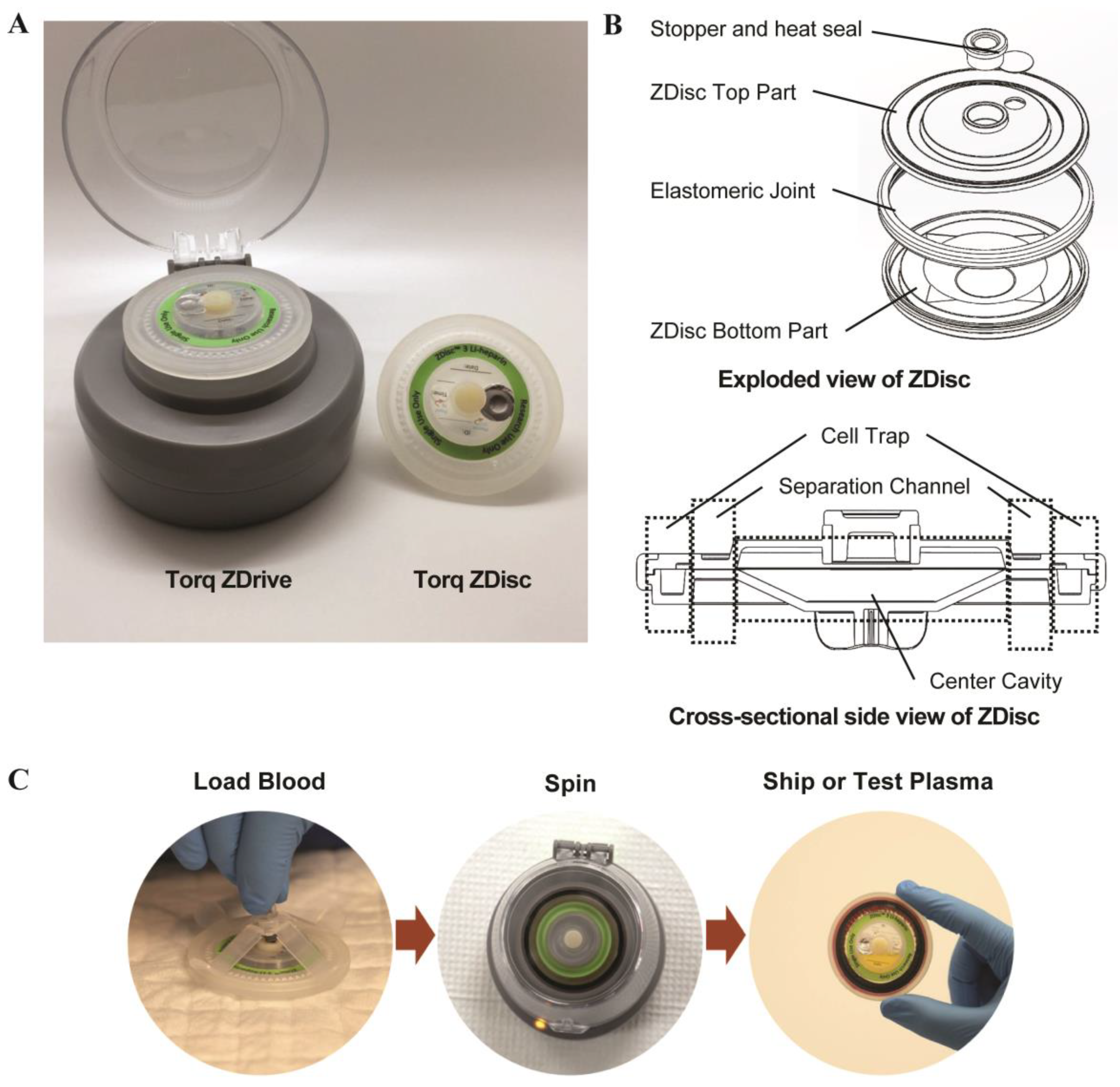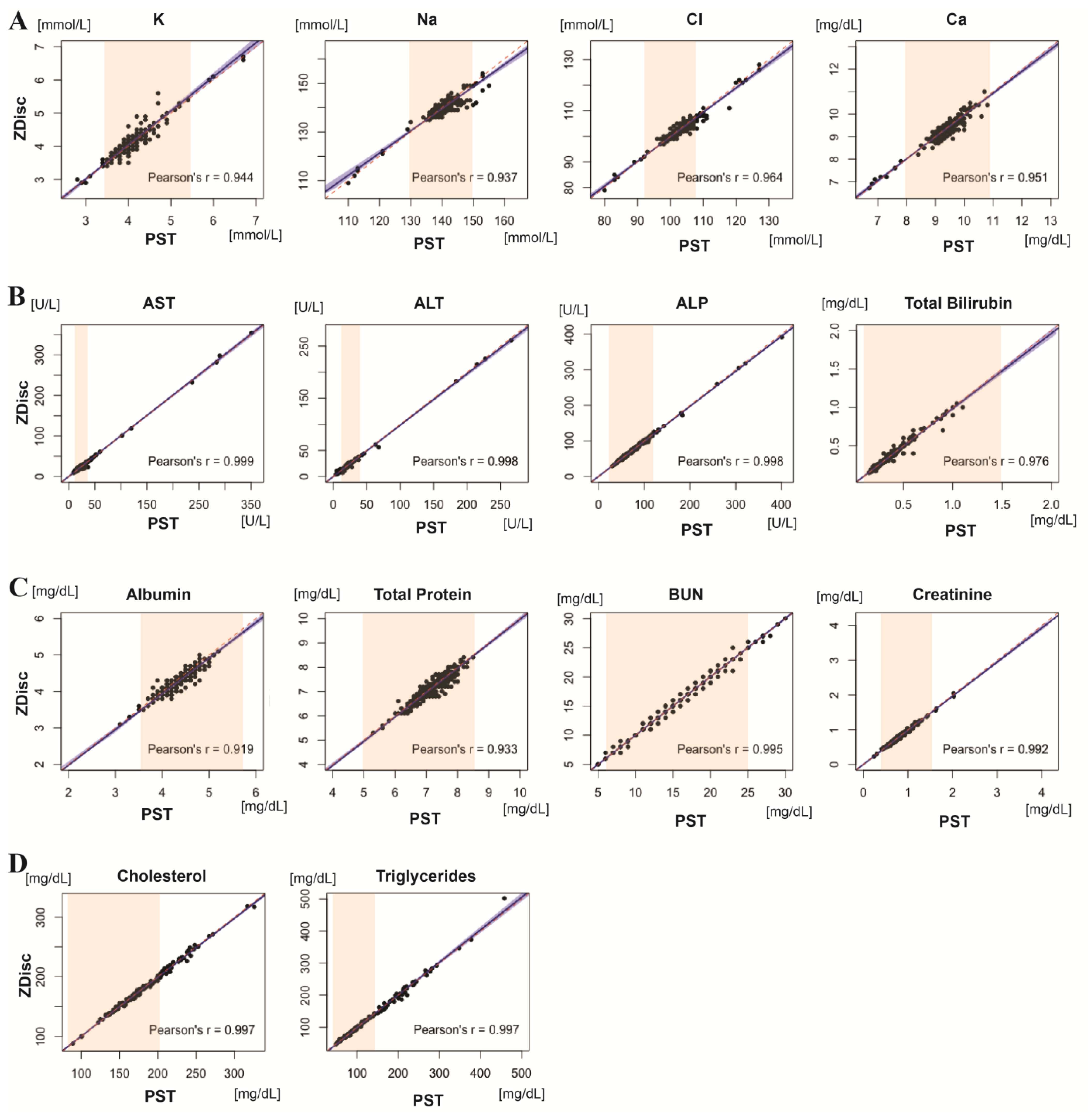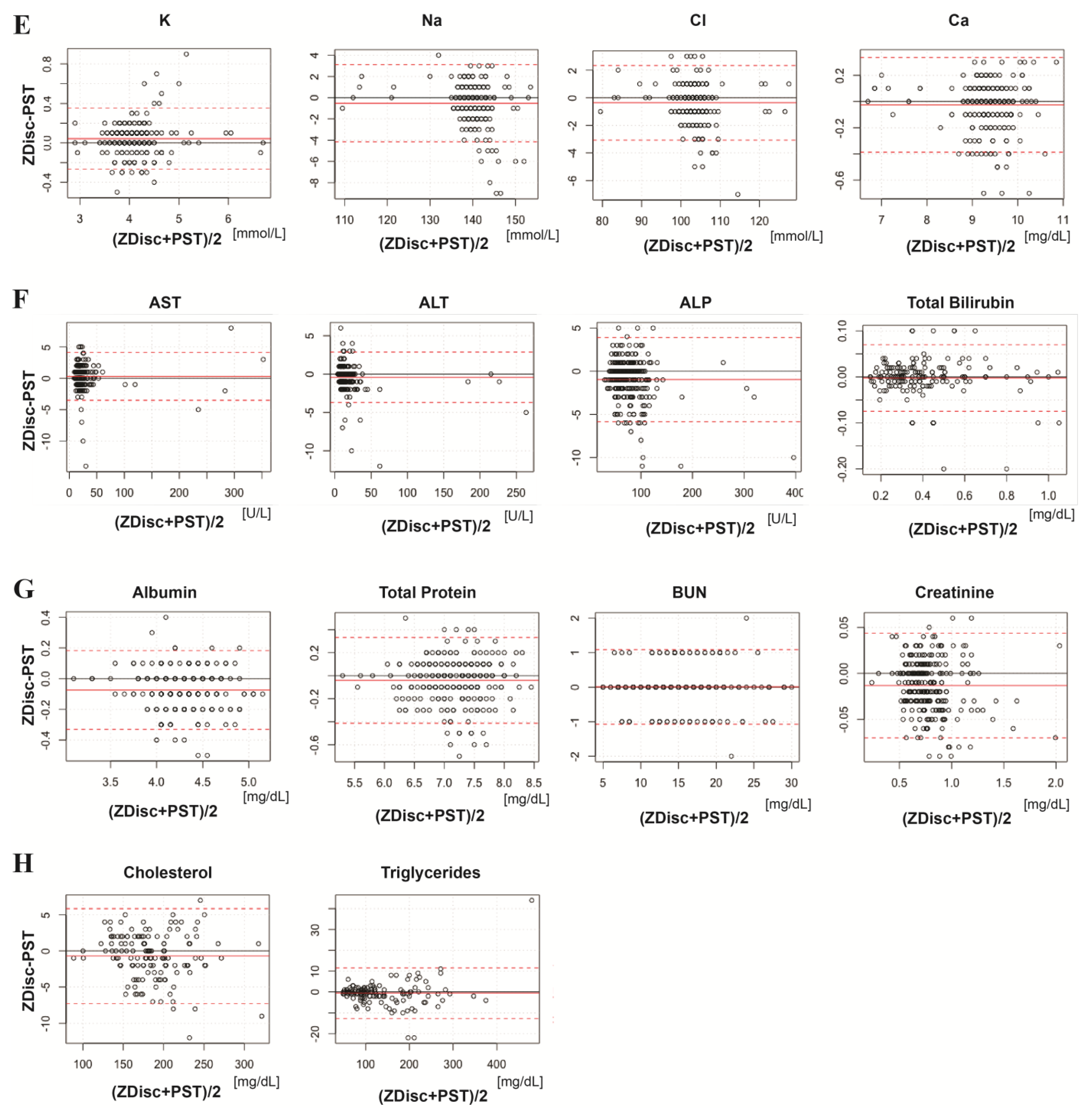Clinical Evaluation of the Torq Zero Delay Centrifuge System for Decentralized Blood Collection and Stabilization
Abstract
1. Introduction
2. Materials and Methods
2.1. Chemicals and Reagents
2.2. Subject Recruitment
2.3. Performance Comparison Study
2.4. Precision Study
2.5. Plasma Quality
2.6. Data Analysis
3. Results
3.1. Performance Comparison
3.2. Precision
3.3. Plasma Quality
4. Discussion
Supplementary Materials
Author Contributions
Funding
Institutional Review Board Statement
Informed Consent Statement
Acknowledgments
Conflicts of Interest
References
- CLSI. Procedures for the handling and processing of blood specimens for common laboratory tests. In Approved Guideline, 4th ed.; CLSI document H18-A2010; CLSI: Annapolis Junction, MD, USA, 2010. [Google Scholar]
- Plebani, M. Errors in clinical laboratories or errors in laboratory medicine? Clin. Chem. Lab. Med. 2006, 44, 750–759. [Google Scholar] [CrossRef]
- Plebani, M.; Carraro, P. Mistakes in a stat laboratory: Types and frequency. Clin. Chem. 1997, 43, 1348–1351. [Google Scholar] [CrossRef]
- Kalra, J. Medical errors: Impact on clinical laboratories and other critical areas. Clin. Biochem. 2004, 37, 1052–1062. [Google Scholar] [CrossRef]
- Green, S.F. The cost of poor blood specimen quality and errors in preanalytical processes. Clin. Biochem. 2013, 46, 1175–1179. [Google Scholar] [CrossRef]
- Bonini, P.; Plebani, M.; Ceriotti, F.; Rubboli, F. Errors in Laboratory Medicine. Clin. Chem. 2002, 48, 691–698. [Google Scholar] [CrossRef]
- Tripathi, S.; Kumar, Y.V.B.V.; Prabhakar, A.; Joshi, S.S.; Agrawal, A. Passive blood plasma separation at the microscale: A review of design principles and microdevices. J. Micromech. Microeng. 2015, 25. [Google Scholar] [CrossRef]
- Bhamla, M.S.; Benson, B.; Chai, C.; Katsikis, G.; Johri, A.; Prakash, M. Hand-powered ultralow-cost paper centrifuge. Nat. Biomed. Eng. 2017, 1. [Google Scholar] [CrossRef]
- Yang, S.; Ündar, A.; Zahn, J.D. A microfluidic device for continuous, real time blood plasma separation. Lab. Chip. 2006, 6, 871–880. [Google Scholar] [CrossRef]
- Chen, X.; Cui, D.F.; Liu, C.C.; Li, H. Microfluidic chip for blood cell separation and collection based on crossflow filtration. Sens. Actuators B Chem. 2008, 130, 216–221. [Google Scholar] [CrossRef]
- Jung, J.; Han, K.-H. Lateral-driven continuous magnetophoretic separation of blood cells. Appl. Phys. Lett. 2008, 93, 223902. [Google Scholar] [CrossRef]
- Faivre, M.; Abkarian, M.; Bickraj, K.; Stone, H.A. Geometrical focusing of cells in a microfluidic device: An approach to separate blood plasma. Biorheology 2006, 43, 147–159. [Google Scholar] [PubMed]
- Bowen, R.A.; Remaley, A.T. Interferences from blood collection tube components on clinical chemistry assays. Biochem. Med. 2014, 24, 31–44. [Google Scholar] [CrossRef]
- Daves, M.; Trevisan, D.; Cemin, R. Different collection tubes in cardiac biomarkers detection. J. Clin. Lab. Anal. 2008, 22, 391–394. [Google Scholar] [CrossRef]
- Babic, N.; Zibrat, S.; Gordon, I.O.; Lee, C.C.; Yeo, K.-T.J. Effect of blood collection tubes on the incidence of artifactual hyperkalemia on patient samples from an outreach clinic. Clin. Chim. Acta 2012, 413, 1454–1458. [Google Scholar] [CrossRef] [PubMed]
- World Health Organization. Use of Anticoagulants in Diagnostic Laboratory: Stability of Blood, Plasma and Serum Samples; WHO: Geneva, Switzerland, 2002. [Google Scholar]
- CLSI. Validation and Verification of Tubes for Venous and Capillary Blood Specimen Collection, 1st ed.; CLSI: Annapolis Junction, MD, USA, 2016. [Google Scholar]
- Dominiczak, M.H. Tietz textbook of clinical chemistry. Clin. Chem. Lab. Med. 2006, 37, 1136. [Google Scholar] [CrossRef]
- Naithani, M.; Singh, P. Teitz textbook of clinical chemistry & molecular diagnostics. Med. J. Armed Forces India 2006, 62, 204. [Google Scholar] [CrossRef][Green Version]
- Kratz, A.; Ferraro, M.; Sluss, P.M.; Lewandrowski, K.B. Laboratory reference values. N. Engl. J. Med. 2004, 351, 1548–1564. [Google Scholar] [CrossRef] [PubMed]
- Fischbach, F.; Dunning, M.B., III. A Manual of Laboratory and Diagnostic Tests; Lippincott Williams & Wilkins: Philadelphia, PA, USA, 2015. [Google Scholar]
- Ricchiuti, V. Tietz textbook of clinical chemistry. Am. J. Clin. Pathol. 1999, 112, 120–121. [Google Scholar] [CrossRef][Green Version]
- Lammers, W.; van Buuren, H.R.; Hirschfield, G.; Janssen, H.L.; Invernizzi, P.; Mason, A.L.; Ponsioen, C.Y.; Floreani, A.; Corpechot, C.; Mayo, M.J.; et al. Levels of alkaline phosphatase and bilirubin are surrogate end points of outcomes of patients with primary biliary cirrhosis: An international follow-up study. Gastroenterology 2014, 147, 1338–1349.e5. [Google Scholar] [CrossRef] [PubMed]
- CLSI. Evaluation of precision of quantitative measurement procedures. In Approved Guideline, 3rd ed.; CLSI: Annapolis Junction, MD, USA, 2014. [Google Scholar]
- Malinauskas, R.A. Plasma hemoglobin measurement techniques for the in vitro evaluation of blood damage caused by medical devices. Artif. Organs 1997, 21, 1255–1267. [Google Scholar] [CrossRef] [PubMed]
- Lippi, G.; Salvagno, G.L.; Montagnana, M.; Brocco, G.; Guidi, G.C. Influence of hemolysis on routine clinical chemistry testing. Clin. Chem. Lab. Med. 2006, 44, 311–316. [Google Scholar] [CrossRef] [PubMed]
- Domingues, C.; Carneiro, R.; Dias, M. Correction of factitious hyperkalemia in hemolysed specimens from adult emergency department using the Beckman Coulter Unicell DxC 880i® analyzer derived factor. J. Pharm. Pharmacol. 2017, 5, 902–906. [Google Scholar] [CrossRef][Green Version]
- Benson, K. Guide to the preparation, use and quality assurance of blood components. Transfusion 1999, 39, 547. [Google Scholar] [CrossRef]
- Westgard QC. Desirable Biological Variation Database Specifications. Westgard, James. 2014. Available online: https://www.westgard.com/biodatabase1.htm (accessed on 11 September 2020).
- Ricós, C.; Alvarez, V.; Cava, F.; García-Lario, J.V.; Hernández, A.; Jiménez, C.V.; Minchinela, J.; Perich, C.; Simón, M. Current databases on biological variation: Pros, cons and progress. Scand. J. Clin. Lab. Investig. 1999, 59, 491–500. [Google Scholar]
- Kachhawa, K.; Kachhawa, P.; Varma, M.; Behera, R.; Agrawal, D.; Kumar, S. Study of the stability of various biochemical analytes in samples stored at different predefined storage conditions at an accredited laboratory of India. J. Lab. Physicians 2017, 9, 11–15. [Google Scholar] [CrossRef] [PubMed]
- Baer, D.M.; Ernst, D.J.; Willeford, S.I.; Gambino, R. Investigating elevated potassium values. Med Lab. Obs. 2006, 38, 24–31. [Google Scholar]
- Elrouf, M.; Amanullah, M.; Zaman, G. Interference of hemolysis in the estimation of plasma aspartate aminotransferase, potassium and phosphate. J. Investig. Biochem. 2014, 1, 12–16. [Google Scholar] [CrossRef]
- Heins, M.; Schossow, B.; Greiner, L.; Heil, W. Influence of storage time and temperature on haematological measurands using a Sysmex NE 8000 analyser. Lab. Med. 2000, 24, 236–242. [Google Scholar]
- Zhang, D.J.; Elswick, R.K.; Miller, W.G.; Bailey, J.L. Effect of serum-clot contact time on clinical chemistry laboratory results. Clin. Chem. 1998, 44, 1325–1333. [Google Scholar] [CrossRef]



| Analyte | Lower MDL | Upper MDL |
|---|---|---|
| K | 3.5 mmol/L | 5.5 mmol/L |
| Na | 130 mmol/L | 150 mmol/L |
| Cl | 95 mmol/L | 109 mmol/L |
| Ca | 8.6 mg/dL | 10.3 mg/dL |
| BUN | 6 mg/dL | 25 mg/dL |
| Cre | 1.5 mg/dL | 0.4 mg/dL |
| AST | N/A | 35 U/L |
| ALT | N/A | 35 U/L |
| ALP | N/A | 120 U/L |
| T.Bili | 0.3 mg/dL | 1.5 mg/dL |
| Alb | 3.5 g/dL | 5.5 g/dL |
| TP | 5.5 g/dL | 9.0 g/dL |
| Chol | N/A | 200 mg/dL |
| TRIG | N/A | 150 mg/dL |
| Site/Analyzer | K | Na | Cl | Ca | AST | ALT | ALP | |
|---|---|---|---|---|---|---|---|---|
| Site 1 | Analyzer 1 | −0.648 | 1.264 | 0.991 | 1.445 | −0.386 | 2.783 | 2.783 |
| Analyzer 2 | −1.866 | −0.082 | −0.379 | −0.445 | −0.387 | 0.517 | 0.517 | |
| Analyzer Pooled | −1.257 | 0.591 | 0.306 | 0.500 | −0.387 | 1.650 | 1.650 | |
| Site 2 | Analyzer 1 | −0.339 | 0.449 | 0.477 | 0.957 | −1.286 | 2.195 | 2.195 |
| Analyzer 2 | −0.870 | 0.206 | 0.320 | 0.042 | −1.582 | 0.752 | 0.752 | |
| Analyzer Pooled | −0.604 | 0.328 | 0.399 | 0.499 | −1.434 | 1.474 | 1.474 | |
| Site 3 | Analyzer 1 | −1.748 | 0.002 | 0.175 | −0.406 | −4.234 | 0.147 | 0.147 |
| Analyzer 2 | −0.728 | 0.256 | 0.451 | −0.241 | −3.182 | 0.501 | 0.501 | |
| Analyzer Pooled | −1.238 | 0.129 | 0.313 | −0.323 | −3.708 | 0.324 | 0.324 | |
| 3 sites pooled/Analyzer 1 | −0.857 | 0.605 | 0.570 | 0.722 | −1.810 | 4.328 | 1.805 | |
| 3 sites pooled/Analyzer 2 | −1.178 | 0.120 | 0.113 | −0.208 | −1.617 | 0.212 | 0.597 | |
| Total | −1.018 | 0.362 | 0.341 | 0.257 | −1.714 | 2.270 | 1.201 | |
| Site/Analyzer | Total Bilirubin | Albumin | Total Protein | BUN | Creatinine | Cholesterol | Triglycerides | |
| Analyzer 1 | 2.206 | 2.878 | 1.979 | 0.665 | 1.875 | N/A | N/A | |
| Analyzer 2 | 0.593 | 1.290 | 0.541 | 0.525 | 1.808 | 0.331 | 1.038 | |
| Analyzer Pooled | 1.400 | 2.084 | 1.260 | 0.595 | 1.841 | 0.331 | 1.038 | |
| Analyzer 1 | 3.971 | 2.166 | 1.187 | −0.730 | 1.929 | N/A | N/A | |
| Analyzer 2 | −0.299 | 1.296 | −0.326 | 0.093 | 1.821 | 0.416 | 0.038 | |
| Analyzer Pooled | 1.836 | 1.731 | 0.431 | −0.319 | 1.875 | 0.416 | 0.038 | |
| Analyzer 1 | −2.452 | 1.141 | 0.137 | −0.999 | 0.787 | N/A | N/A | |
| Analyzer 2 | −2.488 | 1.297 | −0.249 | 0.245 | 1.504 | 0.259 | 0.680 | |
| Analyzer Pooled | −2.470 | 1.219 | −0.056 | −0.377 | 1.146 | 0.259 | 0.680 | |
| 3 sites pooled/Analyzer 1 | 1.513 | 2.119 | 1.153 | −0.319 | 1.575 | N/A | N/A | |
| 3 sites pooled/Analyzer 2 | −0.616 | 1.294 | −0.003 | 0.289 | 1.723 | 0.340 | 0.575 | |
| Total | 0.449 | 1.706 | 0.575 | −0.015 | 1.649 | 0.340 | 0.575 | |
| Analyte (Sample Size, n) | Lot-to-Lot Precision Mean % CV (95% Confidence Interval) | Inter-operator Precision Mean % CV (95% Confidence Interval) | ||||
|---|---|---|---|---|---|---|
| Between Lot | Within Lot | Total | Between Operator | Within Operator | Total | |
| K (mmol/L) (n = 171) | 0.63 (0.00–1.21) | 2.82 (2.52–3.19) | 2.89 (2.56–3.31) | 0.83 (0.00–1.38) | 2.75 (2.46–3.10) | 2.87 (2.55–3.27) |
| Na (mmol/L) (n = 171) | 0.09 (0.00–0.21) | 0.72 (0.64–0.71) | 0.72 (0.65–0.82) | 0.06 (0.00–0.18) | 0.67 (0.60–0.76) | 0.67 (0.61–0.76) |
| Cl (mmol/L) (n = 171) | 0.15 (0.00–0.30) | 0.80 (0.71–0.91) | 0.81 (0.72–0.93) | 0.05 (0.00–0.22) | 0.88 (0.79–0.99) | 0.88 (0.79–0.99) |
| Ca (mg/dL) (n = 166) | 0.22 (0.00–0.42) | 0.91 (0.81–1.03) | 0.93 (0.83–1.08) | 0.18 (0.00–0.49) | 1.68 (1.50–1.91) | 1.69 (1.51–1.91) |
| BUN (mg/dL) (n = 168) | 0.34 (0.00–0.75) | 2.45 (2.19–2.77) | 2.47 (2.20–2.81) | 0.27 (0.00–0.66) | 2.21 (1.98–2.50) | 2.23 (2.00–2.52) |
| Cre (mg/dL) (n = 165) | 0.14 (0.00–0.58) | 2.75 (2.45–3.12) | 2.75 (2.46–3.12) | 0.00 * | 2.82 (2.52–3.19) | 2.82 (2.53–3.18) |
| AST (U/L) (n = 173) | 2.11 (0.00–3.80) | 6.06 (5.42–6.86) | 6.41 (5.54–7.62) | 1.89 (0.00–3.12) | 6.22 (5.59–7.02) | 6.50 (5.79–7.41) |
| ALT (U/L) (n = 172) | 1.04 (0.00–2.21) | 6.85 (6.13–7.76) | 6.93 (6.19–7.87) | 0.96 (0.00–2.01) | 6.12 (5.49–6.91) | 6.19 (5.56–6.98) |
| ALP (U/L) (n = 174) | 0.41 (0.00–0.78) | 1.76 (1.58–1.99) | 1.81 (1.60–2.07) | 0.74 (0.00–1.13) | 1.48 (1.33–1.68) | 1.66 (1.43–1.97) |
| T.Bili (mg/dL) (n = 163) | 0.62 (0.00–1.33) | 4.15 (3.70–4.72) | 4.19 (3.73–4.78) | 0.61 (0.00–1.36) | 4.16 (3.72–4.73) | 4.21 (3.76–4.77) |
| Alb (mg/dL) (n = 170) | 0.85 (0.00–1.52) | 2.08 (1.86–2.36) | 2.25 (1.90–2.76) | 0.74 (0.00–1.17) | 1.88 (1.68–2.12) | 2.02 (1.77–2.34) |
| TP (mg/dL) (n = 169) | 0.61 (0.00–1.08) | 1.51 (1.35–1.71) | 1.63 (1.38–1.99) | 0.80 (0.00–1.23) | 1.48 (1.32–1.67) | 1.68 (1.43–2.03) |
| Chol (mg/dL) (n = 170) | 0.36 (0.00 *–0.72) | 1.85 (1.65–2.09) | 1.88 (1.68–2.15) | 0.82 (0.00 *–1.26) | 1.61 (1.45–1.82) | 1.81 (1.55–2.16) |
| TRIG (mg/dL) (n = 170) | 0.00 * | 2.18 (1.95–2.47) | 2.18 (1.95–2.47) | 0.13 (0.00 *–0.51) | 1.99 (1.78–2.25) | 1.99 (1.79–2.25) |
| Parameters | RBC (M/mL) Threshold: 6 M/mL | WBC (M/mL) Threshold: 0.1 M/mL | PLT (M/mL) Threshold: 50 M/mL | Mean Hb (mg/dL) Threshold: 100 mg/mL |
|---|---|---|---|---|
| Average | 1.30 | 0.045 | 2.79 | 8.03 |
| 95% CI | 1.08–1.52 | 0.035–0.056 | 1.91–3.67 | 6.44–9.62 |
Publisher’s Note: MDPI stays neutral with regard to jurisdictional claims in published maps and institutional affiliations. |
© 2021 by the authors. Licensee MDPI, Basel, Switzerland. This article is an open access article distributed under the terms and conditions of the Creative Commons Attribution (CC BY) license (https://creativecommons.org/licenses/by/4.0/).
Share and Cite
Hong, K.; Iacovetti, G.; Rahimian, A.; Hong, S.; Epperson, J.; Neal, C.; Pan, T.; Le, A.; Kendall, E.; Melton, K.; et al. Clinical Evaluation of the Torq Zero Delay Centrifuge System for Decentralized Blood Collection and Stabilization. Diagnostics 2021, 11, 1019. https://doi.org/10.3390/diagnostics11061019
Hong K, Iacovetti G, Rahimian A, Hong S, Epperson J, Neal C, Pan T, Le A, Kendall E, Melton K, et al. Clinical Evaluation of the Torq Zero Delay Centrifuge System for Decentralized Blood Collection and Stabilization. Diagnostics. 2021; 11(6):1019. https://doi.org/10.3390/diagnostics11061019
Chicago/Turabian StyleHong, Kyungjin, Gabriella Iacovetti, Ali Rahimian, Sean Hong, Jon Epperson, Clara Neal, Tifany Pan, Angela Le, Eric Kendall, Kory Melton, and et al. 2021. "Clinical Evaluation of the Torq Zero Delay Centrifuge System for Decentralized Blood Collection and Stabilization" Diagnostics 11, no. 6: 1019. https://doi.org/10.3390/diagnostics11061019
APA StyleHong, K., Iacovetti, G., Rahimian, A., Hong, S., Epperson, J., Neal, C., Pan, T., Le, A., Kendall, E., Melton, K., Sommer, G. J., & Schaff, U. Y. (2021). Clinical Evaluation of the Torq Zero Delay Centrifuge System for Decentralized Blood Collection and Stabilization. Diagnostics, 11(6), 1019. https://doi.org/10.3390/diagnostics11061019






